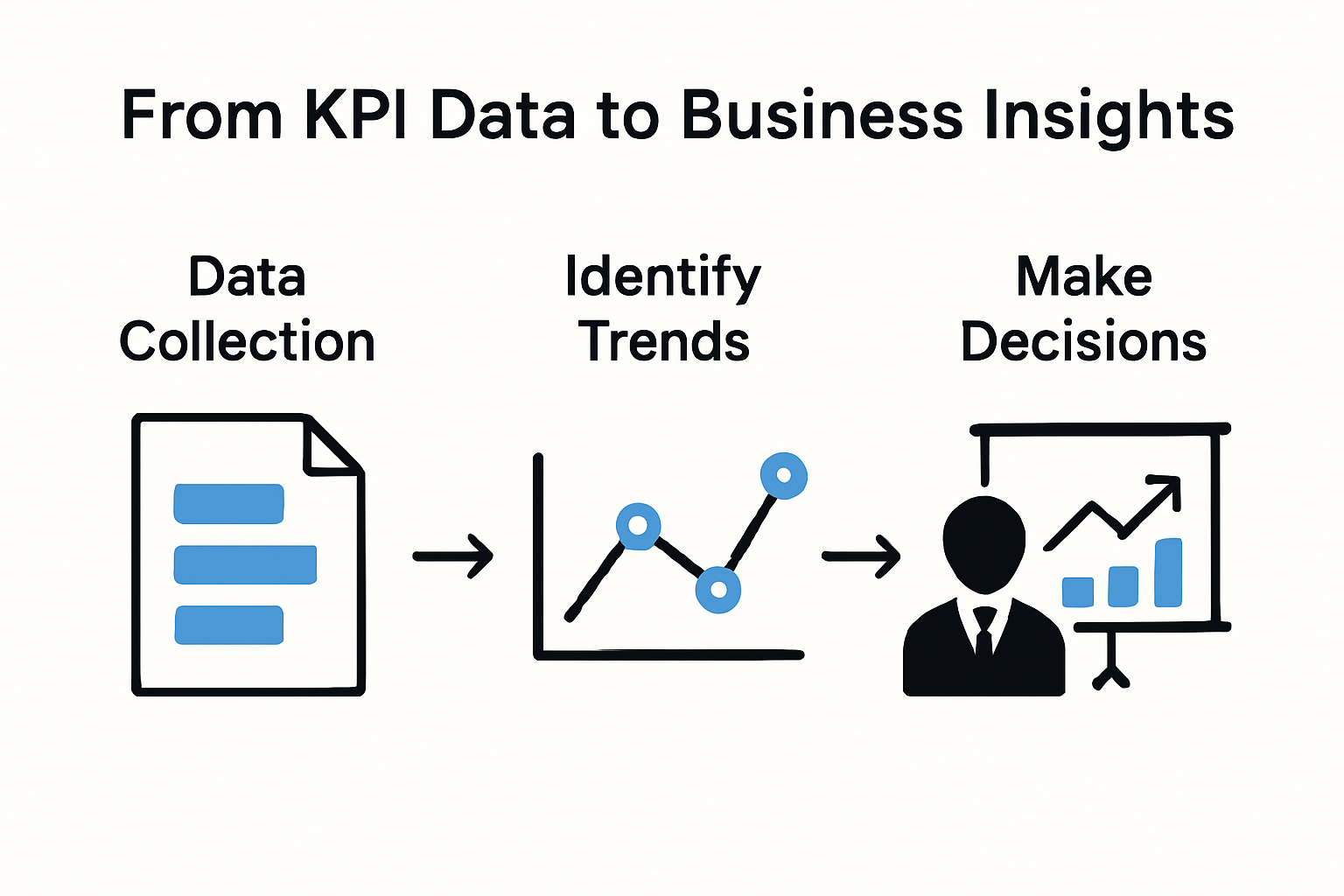Tracking business KPIs used to be a checkbox activity for many companies. Now leaders know it means much more. Companies that systematically track KPIs are 35 percent more likely to hit their strategic goals. Surprised? Most people think the real challenge is picking the right numbers. The real breakthrough happens when businesses use those numbers as a springboard for swift action and smarter decisions. The secrets to real performance improvement in 2025 might look nothing like the old playbook.
Table of Contents
- Why Tracking Business KPIs Matters
- Choosing the Right KPIs for Your Goals
- Best Tools for Tracking Business KPIs in 2025
- Tips for Effective KPI Measurement and Action
Quick Summary
| Takeaway | Explanation |
|---|---|
| Tracking KPIs is essential for success | Businesses that monitor KPIs are more likely to achieve their strategic objectives effectively. |
| Choose KPIs that align with goals | Selecting relevant KPIs ensures that metrics measure performance that matters to your specific objectives. |
| Utilize advanced tools for tracking | Leveraging sophisticated analytics platforms can deliver deeper insights and predictive capabilities for informed decision-making. |
| Foster a culture of continuous improvement | Engaging team members in KPI discussions creates a dynamic environment focused on leveraging insights for strategic actions. |
| Regularly review and adapt KPIs | Leaders should reassess and adjust KPIs based on performance insights to remain aligned with evolving business priorities. |
Why Tracking Business KPIs Matters
In the dynamic world of business, understanding performance is not just an option—it’s a critical survival strategy. Key Performance Indicators (KPIs) serve as the vital signs of an organization, providing real-time insights into operational health and strategic progress.
The Strategic Importance of Performance Measurement
Businesses today operate in an increasingly complex environment where data-driven decision making separates successful organizations from struggling ones. Tracking performance metrics enables leaders to move beyond intuition and ground their strategies in concrete, measurable evidence.
According to research from business analytics experts, organizations that systematically track KPIs are 35% more likely to achieve their strategic objectives. These metrics provide a comprehensive view of organizational performance, highlighting areas of strength and pinpointing potential improvement zones.
Transforming Data into Actionable Insights
Effective KPI tracking goes beyond merely collecting numbers. It’s about transforming raw data into meaningful insights that drive strategic decision-making. When businesses understand their performance metrics, they can:
- Identify Trends: Recognize emerging patterns in business performance
- Predict Challenges: Anticipate potential obstacles before they become critical
- Align Strategies: Ensure organizational activities are consistently moving toward core business goals
By implementing robust KPI tracking mechanisms, leaders gain the ability to make proactive, informed decisions. This approach eliminates guesswork and replaces it with a structured, data-driven management philosophy.
Competitive Advantage Through Precise Measurement
In 2025, businesses that master KPI tracking will have a significant competitive edge. The ability to quickly interpret performance data and make rapid, strategic adjustments is no longer a luxury—it’s a fundamental requirement for sustainable success.
Leaders who embrace comprehensive KPI tracking create organizations that are agile, responsive, and consistently aligned with their strategic vision. Learn more about optimizing project performance to understand how precise measurement transforms business operations.
Ultimately, tracking business KPIs is about creating a culture of continuous improvement, transparency, and strategic clarity. It empowers teams, guides leadership decisions, and provides a clear roadmap for organizational growth and success.

Choosing the Right KPIs for Your Goals
Selecting the appropriate Key Performance Indicators (KPIs) is a critical process that requires strategic thinking and a deep understanding of organizational objectives. Not all metrics are created equal, and the most effective KPIs are those that directly align with your specific business goals and provide meaningful insights into performance.
Understanding KPI Alignment and Relevance
The foundation of choosing the right KPIs lies in creating a clear connection between organizational strategies and measurable outcomes. According to research from business process management experts, successful KPI selection involves a methodical approach that goes beyond simple number tracking.
Businesses must first identify their core objectives and then determine which metrics will most effectively demonstrate progress. This process requires careful consideration of both quantitative and qualitative indicators that provide a comprehensive view of organizational performance.
Strategies for Effective KPI Selection
Experts recommend a targeted approach to KPI selection that focuses on a few meaningful metrics rather than overwhelming teams with excessive data points. Key strategies include:
- Specificity: Choose KPIs that are directly tied to specific business objectives
- Measurability: Ensure metrics can be accurately tracked and quantified
- Actionability: Select indicators that provide insights that can drive meaningful change
The University of California’s strategic planning approach highlights the importance of creating a robust reporting mechanism that allows for regular review and adjustment of performance metrics. This dynamic approach ensures that KPIs remain relevant and aligned with evolving business goals.
Contextualizing KPIs Across Different Business Domains
Different departments and business functions require unique sets of KPIs. Marketing teams might focus on customer acquisition costs and conversion rates, while sales teams track revenue growth and pipeline metrics. Operations might prioritize efficiency indicators, and customer service teams could emphasize satisfaction scores.
Learn more about optimizing project performance tracking to understand how tailored KPIs can transform your business intelligence approach.
Ultimately, the most effective KPI strategy is one that balances simplicity with depth. By carefully selecting indicators that provide genuine insights, businesses can create a powerful framework for continuous improvement and strategic decision-making. The goal is not to collect data, but to generate actionable intelligence that drives organizational success.
To further clarify how different business departments focus on unique KPIs aligned with their goals, the following table compares common KPI examples across departments.
| Department | Example KPIs | Performance Focus |
|---|---|---|
| Marketing | Customer Acquisition Cost, Conversion Rate | Campaign effectiveness, lead quality |
| Sales | Revenue Growth, Pipeline Metrics | Sales performance, opportunity tracking |
| Operations | Efficiency Indicators | Process optimization, cost management |
| Customer Service | Satisfaction Scores | Customer experience, retention |
Best Tools for Tracking Business KPIs in 2025
In the rapidly evolving business technology landscape, selecting the right KPI tracking tools can dramatically transform organizational performance. The year 2025 presents a diverse array of sophisticated solutions designed to provide unprecedented insights and actionable intelligence for business leaders.
Advanced Analytics and Visualization Platforms
Modern KPI tracking tools go far beyond traditional spreadsheet approaches. Research demonstrates that while platforms like Google Sheets offer basic collaboration capabilities, businesses require more robust systems for comprehensive performance management.
Cutting-edge analytics platforms now integrate artificial intelligence and machine learning to provide predictive insights. These tools can automatically identify trends, forecast potential challenges, and suggest optimization strategies. Research from interactive data analysis studies highlights the importance of systems that enable users to conduct dynamic ‘what-if’ scenario analyses, allowing leaders to experiment with potential strategic adjustments.
Enterprise-Level KPI Tracking Solutions
For organizations seeking comprehensive performance monitoring, enterprise-level tools offer sophisticated tracking mechanisms. Advanced web analytics frameworks like CAWAL provide integrated solutions that combine multiple data sources, offering precise tracking across different business domains.
Key features to look for in 2025 include:
- Real-time Data Integration: Seamless connections between different business systems
- Predictive Analytics: AI-powered forecasting and trend identification
- Customizable Dashboards: Personalized views tailored to specific organizational needs
- Cross-Platform Compatibility: Accessibility across various devices and operating systems
Emerging Technologies in KPI Monitoring
The future of KPI tracking lies in intelligent, adaptive systems that can learn and evolve with organizational needs. Artificial intelligence and machine learning are transforming how businesses understand and interact with their performance data.
Learn more about automating business performance tracking to understand how technology is revolutionizing performance management.
Businesses must approach tool selection strategically, considering factors like scalability, integration capabilities, and alignment with specific organizational goals. The right KPI tracking tool is not just a technology investment—it’s a strategic asset that can provide competitive advantages in an increasingly data-driven business environment.
As we move further into 2025, the most successful organizations will be those that view KPI tracking not as a passive reporting mechanism, but as an active, intelligent system for continuous improvement and strategic decision-making.
To help compare different classes of KPI tracking tools discussed, the table below summarizes their main features and capabilities.
| Tool Type | Capabilities | Best For |
|---|---|---|
| Analytics & Visualization Platforms | Trend analysis, AI insights, scenario modeling | Dynamic reporting, experiment-driven teams |
| Enterprise-Level KPI Solutions | Real-time data, dashboards, cross-platform integration | Large organizations, multi-domain monitoring |
| Spreadsheet-based Tools | Basic collaboration, manual KPI tracking | Small teams, simple use cases |
| AI/ML-Driven Systems | Predictive analytics, automated optimization, adaptive learning | Forward-looking, automation-focused leaders |
Tips for Effective KPI Measurement and Action
Transforming KPI data into meaningful action requires a strategic and disciplined approach. Successful organizations understand that measuring performance is just the first step—the real value emerges from how leaders interpret and act on these insights.
Developing a Robust KPI Measurement Framework
Performance measurement experts highlight the critical importance of a structured approach to KPI development. This involves defining clear objectives, identifying relevant metrics, and establishing precise targets that align with organizational goals.
The Balanced Scorecard Institute’s MPRA framework provides a disciplined methodology for implementing an effective KPI system. Key elements include articulating strategic intent, selecting meaningful indicators, and establishing a long-term performance measurement discipline.
Strategies for Actionable KPI Implementation
Effective KPI measurement goes beyond simple data collection. Organizations must create a culture of continuous improvement that transforms metrics into strategic actions. Best practices include:
- Stakeholder Engagement: Involve team members across different departments in KPI definition and interpretation
- Context-Driven Analysis: Look beyond raw numbers to understand the story behind the metrics
- Adaptive Goal Setting: Develop flexible targets that can evolve with changing business conditions
Government performance management guidelines suggest focusing on outcomes rather than just outputs. This means prioritizing metrics that demonstrate genuine impact rather than simply tracking surface-level activities.
Turning KPI Insights into Strategic Action
The most successful organizations treat KPIs as living, dynamic tools for strategic decision-making. This requires a proactive approach that goes beyond traditional reporting. Leaders must:
- Regularly review and challenge existing KPIs
- Create clear action plans based on performance insights
- Establish accountability mechanisms for metric-driven improvements
Learn more about optimizing project performance tracking to understand how to transform data into meaningful organizational progress.
Ultimately, effective KPI measurement is an art and a science. It demands a combination of analytical rigor, strategic thinking, and organizational agility. By treating KPIs as more than just numbers—but as strategic navigation tools—businesses can create a culture of continuous improvement and data-driven excellence.
The most powerful KPI systems are those that not only measure performance but actively drive strategic transformation. They become living, breathing mechanisms that guide organizations toward their most ambitious goals.

Frequently Asked Questions
What are business KPIs and why are they important?
Key Performance Indicators (KPIs) are measurable values that indicate how effectively a company is achieving its key business objectives. They are important because businesses that systematically track KPIs are 35% more likely to meet their strategic goals.
How do I choose the right KPIs for my business?
Choosing the right KPIs involves aligning them with your specific business goals. Focus on metrics that are specific, measurable, and actionable to ensure they provide meaningful insights into performance.
What tools are recommended for tracking KPIs in 2025?
In 2025, businesses should consider advanced analytics and visualization platforms, enterprise-level KPI tracking solutions, and AI/ML-driven systems for comprehensive performance management and predictive analytics.
How can KPI insights drive strategic action?
KPI insights can guide strategic action by highlighting areas of strength and pinpointing improvement zones. By regularly reviewing these insights and creating clear action plans, organizations can enhance their decision-making and overall performance.
Turn KPI Tracking Into Real Results for Your Business
Are you overwhelmed by the challenge of turning your business KPIs into actionable improvements? The article above reveals that simply monitoring performance metrics is not enough. Leaders need streamlined processes and the right tools to actually apply insights, drive efficiency, and save valuable time. Pain points like scattered data, manual reporting, and wasted hours hold teams back from achieving true strategic progress.

Let Gammatica show you how easy KPI tracking and action can be. Automate KPI monitoring, manage projects, and free up to 16 hours weekly with AI-driven productivity tools designed for leaders. Experience seamless workflow management, real-time analytics, and AI-powered suggestions—all in one place. Start transforming your raw KPI data into meaningful action by visiting Gammatica.com today. Don’t wait—explore the difference real integration and automation can make for your organization right now.
Recommended
- Project Progress Tracking: Strategies for Success in 2025 | Gammatica
- Automation for Small Businesses: Essential Strategies for 2025 | Gammatica
- How to Manage Tasks Effectively in 2025: Proven Strategies for Leaders | Gammatica
- Lead Management for Beginners: 2025 Guide for Teams and Leaders | Gammatica



